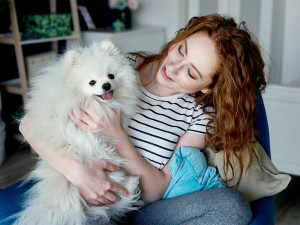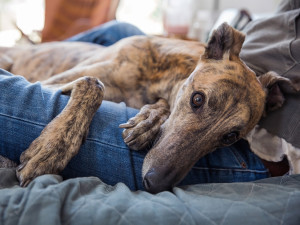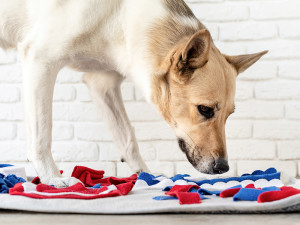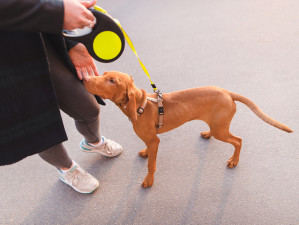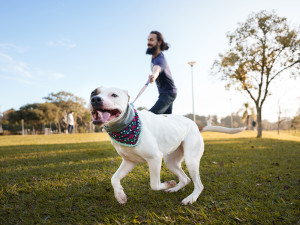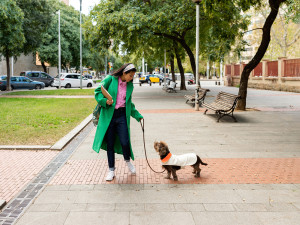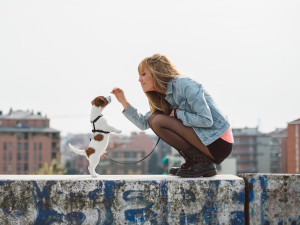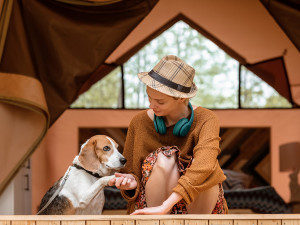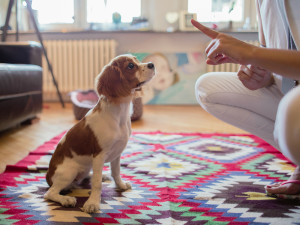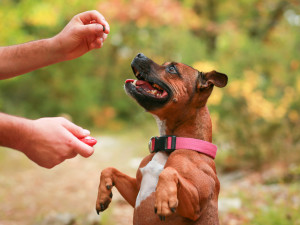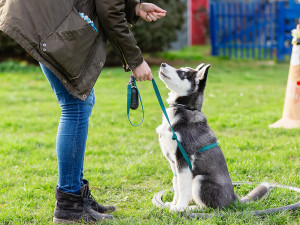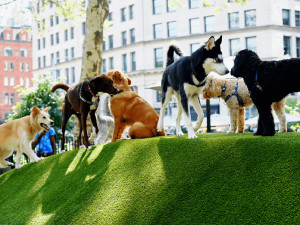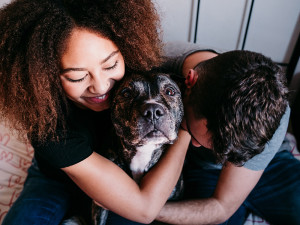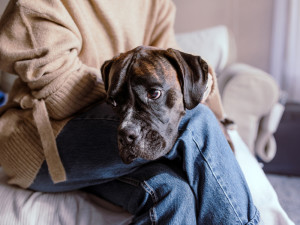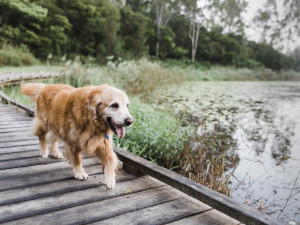How to Teach an Old Dog New Tricks
Your senior dog might move slower these days, but that doesn’t mean they can’t learn new things.

Share Article
The expression “You can’t teach an old dog new tricks,” has done enough damage to dogs and people and the relationship they share, so let’s set the record straight: You can teach old dogs new tricks, and you should teach old dogs new tricks. Not only that, it’s fun to teach old dogs new tricks, and it’s a great kindness to your old dog to do so. If you are looking to train an older dog, these tips for beginners will get you started, and from there, there are no limits to what you and your dog can do together.
Understand Behavior Changes in Your Senior Dog
As dogs get older, their behavior does change, though their general personality and temperament aren’t going to be radically different just because they have celebrated a few more birthdays. Some common behavior changes in older dogs can affect their training, though not every one of them is relevant for each individual dog.
Work With Decreased Appetite
Older dogs slow down as they age, just like people do, so that’s another entry into the “we’re not so different after all” category. Slowing down affects the training of older dogs because they have less energy, so they may not be able to practice coming when called too many times at once or perform other intense behaviors in rapid succession. Dogs who slow down also have a decreased appetite, so it’s best to do training sessions ahead of meals, when they are most hungry and will respond to treats.
Train in Quiet Places
Lots of older dogs develop fears of loud sounds even if they were not sound sensitive when they were younger. One reason this may happen is because when older dogs startle in response to a loud noise, the sudden movement can cause them pain. (So relatable!) They learn to associate the pain with the loud sound and then become scared of such noises. Training places where loud sounds are unlikely to interrupt the training will prevent older dogs from developing any negative associations with the training.

Common Issues with Senior Dogs
There are common issues in senior dogs that we must consider when training adult dogs who are heading into or already in their golden years. Their senses may not be as good, so it might be harder for them to see and hear you. Use very clear visual signals and perhaps louder vocal ones to help your dog get the message.
Pain and Soreness
Pain or soreness in senior dogs may influence how quickly they respond to cues or whether they respond at all. When choosing what behaviors you want to teach an older dog, eliminate those that may cause discomfort. That means no jumping through hoops or up onto high surfaces and no dancing on their back legs. Keep in mind they may struggle to look up at you at a sharp angle or even to lie down frequently. Teaching them to go to their bed, to lift a paw, or to place their head on your lap may be easier for them.
All dogs may have reasons for not performing the behavior you ask them to, but that’s especially true of senior dogs. Not responding is sometimes considered disobedience, but it’s far kinder to try to understand why they didn’t do what you wanted. In the context of modern dog training, it’s best to evaluate whether they are confused, haven’t really learned the skill yet, or feel too much discomfort to do it. Or, in general terms, consider that the dog is not giving you a hard time, the dog is having a hard time.
Different Types of Training to Consider
Although training dogs of all ages follows the same principles, there are some tips for older dogs specifically that make the process easier and more effective. With each type of training, there are details that apply to older dogs.
Crate Training
Crate training a dog of any age involves teaching them to be happy in their crate, and this applies to older dogs as well. Never force them to go into the crate, but set up situations so they want to go in, and repeat them a lot. Put high-quality treats in the front of the crate so they are easy to reach from outside. Once they love going to get those treats, gradually toss them further in so the dog willingly enters the crate.
After they will go all the way in to get treats, start closing the door to the crate, but at first, close it for just a second, being sure to open it before they are done with the treats. Gradually increase the time they are in the crate with the door closed. Once they are comfortable in the crate with the door closed, put them in there for very brief periods — starting with less than a minute — with a stuffed food toy they can work on. Add to the time until they love their crate.
For older dogs specifically, use a crate that does not require them to step high to enter. Put really soft cozy padded bedding in there so they can be comfortable. Don’t leave them in there so long that they reach the point they are desperate to potty or can’t hold it.
Potty Training
Potty training, house training, teaching them where the bathroom is — whatever you call it, it’s an essential skill if we want to enjoy sharing a home with our dogs. Always consider there may be a medical reason an older dog regresses on their house training, and take them to the veterinarian. Similarly, if a recent addition to your family thinks your living room is the bathroom, a visit to the veterinarian is in order. Once medical issues have been treated or ruled out, then you can work on potty training.
A dog who is still being house trained must always be in one of three situations — outside with someone observing to see if they go, inside under constant supervision so you can get them outside ASAP if they show signs of squatting or lifting a leg, or in a confined area such as a crate or laundry room where they are not likely to choose to go. Whenever your dog pees or poops outside, which is what you want, offer calm praise until they are done, and then a treat as fast as you can get it to them. Go to them to deliver the treat, or they will think coming to you or coming inside earned the treat, and we want them to know it was their excellent bathroom choice that led to the treat.
Take older dogs outside more often than you think necessary, sometimes every 20 to 30 minutes because many older dogs can’t hold it for long. If they seem hesitant to go, take them on different surfaces. Some dogs prefer grass, others like leaves, and dirt is preferred by many as well. Offer them opportunities on walks, and in your yard to find out what they prefer.
Leash Training
The key to leash training an older dog is making sure your dog is comfortable and that being on a leash is a happy, fun experience. For comfort for an older dog who is not used to walking on a leash, use a leash that’s as thin and lightweight as possible, and consider a leash that is longer than the standard six-foot leash if your dog prefers to have a little more space. Use a comfortable collar, perhaps with some padding, and don’t make it any tighter than it needs to be to prevent them slipping out if it. Some dogs feel more at ease with the leash attached to a harness instead of the collar, so that is an excellent option. Minimize the weight of any tags and tape them together to prevent the jingling so many dogs find irritating.
To make being on a leash fun, give your dog lots of great treats during leash training — any time the dog is by your side or walking without pulling you, offer a treat. While on leash, let them sniff and enjoy themselves so walking is an adventure and not a chore. Teach them to associate being on a leash with good adventures and locations. So, walk them to the park, or to the car to go someplace fun if they enjoy being in the car.
How to Obedience Train Your Older Dog
Training your older dog to respond to basic cues can make both of your lives so much better, and knowing how allows you to reap the benefits of the effort it takes. Training your dog to do as you ask has so many benefits.
To achieve the goal of training your dog, use positive reinforcement, set your dog up for success by arranging the environment so your dog is not doomed to fail, start with what’s easiest for your dog to learn, and train a little bit multiple times each day. Consistency is the key to training a dog. Train when your dog is most likely to pay attention, leaving times of the day when they struggle to focus for other activities like playing, going on walks, or grooming.
Overview: Tools and Time
Tools: The tools for training an older dog are a leash for outside work in any area that is not fenced, excellent treats that are soft and easy to chew but not too big, a quiet environment, and toys they like. Bring these items as well as your patience because our dogs deserve all kinds of grace when they are learning new things. It won’t go perfectly, and there will be mistakes, and that’s OK.
Time: One of the secrets of professional dog trainers is that short training sessions are the best training sessions. Dogs don’t typically learn well if they are required to concentrate for 10, 15, or 20 minutes or more. Multiple short session of 30 seconds to three minutes multiple times a day are far more effective. You will see big changes in a few days and weeks and even more as the months go by if you stick with short, regular sessions of training. Older dogs may fatigue easily or feel full if you do too much training at once.
Step One
The first step in training your older dog is to somehow get the dog to perform the behavior you want so you can reinforce them, making them more likely to do it in the future. Sometimes the behavior is something the dog naturally does naturally, such as lying down, and for such common behaviors, be ready to respond with a treat or other reinforcement when they do it on their own. Dog trainers refer to this as “catching your dog doing something right,” or “capturing behavior” and it’s a powerful part of training.
Use a Treat
Another option is to lure your dog into position using a treat. Dogs tend to follow their nose, so if you can use a treat to get their nose where you want it, you can elicit the desired behavior. To lure a dog into a sit, for example, put the treat right by their nose and then slowly move it back over their head, which causes many dogs to life their head and put their butt on the ground.
Shaping
Shaping is a process of reinforcing progressively closer approximations of the behavior you want. Many behaviors do not appear fully formed, but you can reinforce your dog along the way to the final goal. For example, if you are teaching your dog to roll over, you start by reinforcing them for lying down in early sessions. As you progress, you reinforce them for lying down on one hip rather than straight in a sphinx position, then for lying on their side, then for making it all the way onto their back. Finally, the dog can only earn the treat for fully rolling over — a behavior that is hard to get them to do fully in a single step.
Step Two
The second step is to add the cue for the behavior you want. It’s one thing to have the dog perform a desired behavior, and another thing entirely to do it because you give them a cue that tells them what you want them to do. Dog trainers consider that the cue is a message to their dog that it’s a green light to perform the behavior in order to receive a treat for doing so. So, how do you connect the cue to the behavior so your dog knows this cue tells them to perform that behavior?
When to Add the Cue
Timing is everything, and a cue should only be taught to a dog after they understand the behavior you are teaching them can lead to treats or other reinforcement. That is not what most people do, but it is what professional trainers do. Instead of saying, “shake” at the beginning of the training process right before you try to get your dog to reach their paw out in your direction, hold off on saying that word until they frequently perform the behavior. If you say the cue before they know the behavior, the word has no meaning to them, and it just becomes background noise to them. That makes it harder to teach them to associate the word with the action.
When your dog knows a certain behavior is likely to be reinforced, and you can reliably predict that the dog is likely to perform the behavior, it’s time to introduce the cue you will use to ask your dog to do it. When you can predict that the dog is likely to present their paw within the next few seconds, say “shake,” and then offer your hand to the dog. If they shake, give them treats. Repeat. A lot. Do it over and over in short sessions over many days until they connect the work “shake,” with shaking your hand with their paw and will reliably offer a paw when they hear the cue.
FAQs
Can an older dog be trained?
Older dogs can be trained and often learn new skills quickly because they have the focus some younger dogs lack.
What age is too late to train a dog?
Dogs continue learning throughout their lives, so it’s never too late to train them. Dogs of any age can learn new tricks, skills, and cues.
Are senior dogs hard to train?
Training older dogs is no harder than training younger dogs. No matter their age, the goal is to teach your dog what you want them to do and reinforce them so they are glad they did it.
How do you train an older dog basic commands?
Older dogs learn basic cues the same way younger dogs do — with lots of repetition and with positive reinforcement, so they understand what to do and want to do it.
What are the seven most common dog cues?
Sit, down, stay, heel, come, leave it, and wait are the most common cues we need our dogs to understand and respond to.
Can I train my dog myself?
It’s always best to train your own dog. Training is about developing an understanding between a person and a dog which enhances communication and benefits the relationship.
What to Keep in Mind About Training a Senior Dog
If you’ve been told you can’t teach an old dog new tricks, you have been misinformed. Older dogs are perfectly capable of learning new skills, tricks, and cues. Training them is not unlike training dogs of any age, though certain modifications make the process kinder and more effective for them. Older dogs benefit from the loving attention of training as much as from the new skills they acquire. Even if the dogs in your household resemble a canine retirement community, training can be a wonderful part of your life and of theirs.

Karen B. London, PhD, CAAB, CPDT-KA
Karen B. London is a certified applied animal behaviorist (CAAB) and certified professional dog trainer (CPDT) who specializes in working with dogs with serious behavioral issues, including aggression. She has written for a variety of magazines including The Bark, Clean Run, and the APDT Chronicle of the Dog, and has published in scientific journals including Behavioral Ecology and Sociobiology, Ethology, Ecology, and Evolution, the Journal of Insect Behavior, and Insectes Sociaux. She is the author of seven books about dog training and canine behavior, including the forthcoming My Dog's Mystery Adventure: And Other Stories From a Canine Behaviorist and Dog Trainer.
Related articles
![Boston terrier being stubborn]()
Dog Training — DIY or Hire a Pro?
When it’s time to call in reinforcements.
![Woman trains with a young husky on a dog training field]()
How to Find a Qualified Trainer for Your New Dog
The questions to ask and credentials to look out for to find the right trainer for your dog, according to a pro.
![dogs at dog park drinking water and playing in pool]()
Dog Park Etiquette: Dog Park Dos and Don’ts
New kid on the block? Follow this trainer’s tips before letting your pet run wild.
![Couple hugs their merle Boxer]()
How to Improve Your Relationship with Your Dog
Animal behaviorist Dr. Karen B. London on how to strengthen your pet-parent bond.
![Sad boxer rests on owners lap, dog doesn't want to be touched]()
How to Tell if Your Dog Is in Pain
And what to do to help them.
![]()
13 Products Your Senior Dog Needs
From doggie diapers to toe grips, this gear will help your pet thrive through their golden years.
